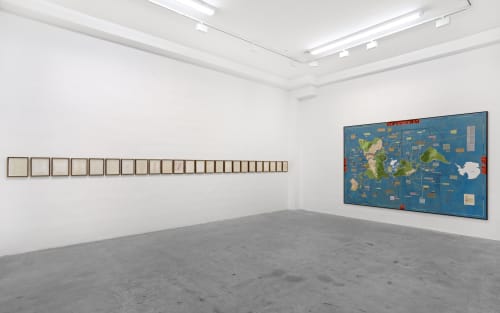Jonathan Marshall: Was Here
GRIMM is pleased to announce Was Here, an exhibition of new works by Jonathan Marshall on view at our New York gallery space. This is the artist’s first solo exhibition in New York and his third solo presentation with the gallery. This series expands on Marshall’s investigation into historical perspectives and how they relate to a sense of place.
To imagine the beginnings of human life, starting with our crude existence in caves and moving through each subsequent chapter of humanity as it has inched and leapt forward, is hardly possible without the invention of systems and instruments of measurement. Hand- making images that organize and convey information is the manner by which Jonathan Marshall reflects on this big picture. For Marshall, thinking out his place in time is tied to a regional identity.
Growing up in the American South, Jonathan Marshall travelled extensively through the coastal area that extends from Florida to Central Texas and many of his new works reflect the lasting impression of this landscape. For this solo presentation, Marshall illuminates moments in the history of the Coastal South, where these narratives are coupled with future visions of the area one begins to trace the development of a personal genealogy. Individual works range from densely illustrated and information-rich to pared down and abstract. In the former, references from popular science and news events, obscure data points, family snapshots and forgotten histories are pulled together to form playful combinations and interactions across time.
For this body of work the artist draws principally from Álvar Núñez Cabeza de Vaca’s chronicle of the Narváez expedition, a harrowing narrative and historical event marking the arrival of the first European colonizers and enslaved African peoples to what would eventually become the American South. Published in 1542, this account tells the story of four survivors from an original crew of 600 men. After the Spanish expedition arrived in Florida searching for gold and new lands to exploit their strategy quickly changed to survival. Eventually, the crew was reduced to four unlikely companions; Cabeza de Vaca, Alonso del Castillo Maldonado, Andrés Dorantes de Carranza and the Moor slave Estevanico. Together they took on the identity of shamans, relying on a combination of charlatanry and uneasy fortune to sustain themselves among the indigenous Americans.
A translation of the Narváez expedition is inscribed onto a gaunt anatomical figure in the work titled La Relación (also the title of Cabeza De Vaca’s published account). In the manner of other works Marshall joins texts with images in combinations that engage with the mechanics of graphic representation. Earthy green and blue shades of acrylic paint compose his calculatedly flat surfaces which are often contrasted by bold taglines. The artist’s fascination with the process of crafting narratives is linked to the mediation of stories and histories within a given time period.
Stories of survival, both new and old, feature as a recurrent source of inspiration for Marshall. Retelling these stories through his works he maps the intersection of determinates that influence fate. The idea of fate predates our notion of risk, a concept which originated in the age of exploration when the imperial powers sponsored expeditions leading to the discovery of the “new world”. The idea that risk can be controlled and avoided is now well-established in affluent nations, whereas stories of survival are recognized for their singularity. A major exception to this conception of risk is presented by climate change. In A Future, an inverted map shows the areas of the southern coastline that will be submerged in water as ocean levels rise, simulated in the image of Spaceship Earth from Walt Disney’s World Resort engulfed by the sea.
Though the future and the distant past can be summoned by our minds, factual and fictional are inevitably reconciled in this process. Marshall’s work asks us what is memorable and how this is interwoven into the mythology of our lives and the places we know.






